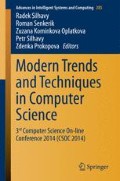Abstract
This research deals with a novel approach to classification. This paper deals with a synthesis of a complex structure which serves as a classifier. Compared to previous research, this paper synthesizes multi-input–multi-output (MIMO) classifiers. Classical artificial neural networks (ANN) were an inspiration for this work. The proposed technique creates a relation between inputs and outputs as a whole structure together with numerical values which could be observed as weights in ANN. The Analytic Programming (AP) was utilized as the tool of synthesis by means of the evolutionary symbolic regression. Iris data (a known benchmark for classifiers) was used for testing of the proposed method. For experimentation, Differential Evolution for the main procedure and also for meta-evolution version of analytic programming was used.
Access this chapter
Tax calculation will be finalised at checkout
Purchases are for personal use only
References
Gurney, K.: An Introduction to Neural Networks. CRC Press, Boca Raton (1997). ISBN 1857285034
Hertz, J., Kogh, A., Palmer, R.G.: Introduction to the Theory of Neural Computation. Addison-Wesley, Reading (1991)
Wasserman, P.D.: Neural Computing: Theory and Practice. Coriolis Group (1980). ISBN 0442207433
Fausett, L.V.: Fundamentals of Neural Networks: Architectures, Algorithms and Applications. Prentice Hall, Englewood Cliffs (1993). ISBN 9780133341867
Fekiac, J., Zelinka, I., Burguillo, J.C.: A review of methods for encoding neural network topologies in evolutionary computation. In: ECMS 2011, Krakow, Poland. ISBN 978-0-9564944-3-6
Back, T., Fogel, D.B., Michalewicz, Z.: Handbook of evolutionary algorithms. Oxford University Press, Oxford (1997). ISBN 0750303921
Koza, J.R., et al.: Genetic Programming III; Darwinian Invention and Problem Solving. Morgan Kaufmann Publisher, Los Altos (1999). ISBN 1-55860-543-6
Koza, J.R.: Genetic Programming. MIT Press, Cambridge (1998). ISBN 0-262-11189-6
O’Neill, M., Ryan, C.: Grammatical Evolution. Evolutionary Automatic Programming in an Arbitrary Language. Kluwer Academic Publishers, Dordrecht (2003). ISBN 1402074441
Zelinka, I., et al.: Analytical programming—A novel approach for evolutionary synthesis of symbolic structures. In: Kita, E. (ed.) Evolutionary Algorithms, InTech (2011). ISBN 978-953-307-171-8
Oplatkova, Z.: Metaevolution: Synthesis of Optimization Algorithms by means of Symbolic Regression and Evolutionary Algorithms. Lambert Academic Publishing, Saarbrücken (2009). ISBN 978-3-8383-1808-0
Zelinka, I., Varacha, P., Oplatkova, Z.: Evolutionary synthesis of neural network. In: 12th International Conference on Softcomputing (Mendel 2006), Brno, Czech Republic, 31 May–2 June 2006, pp. 25–31. ISBN 80-214-3195-4
Zelinka, I., Oplatkova, Z., Nolle, L.: Boolean symmetry function synthesis by means of arbitrary evolutionary algorithms-comparative study. Int. J. Simul. Syst. Sci. Technol. 6(9), 44–56 (2005). ISSN 1473-8031
Fisher, R.A.: The use of multiple measurements in taxonomic problems. Ann. Eugenics 7(2), 179–188 (1936). doi:10.1111/j.1469-1809.1936.tb02137.x
Machine learning repository with Iris data set, http://archive.ics.uci.edu/ml/datasets/Iris
Swain, M., et al.: An approach for iris plant classification using neural network. Int. J. Soft Comput. 3(1) (2012). doi:10.5121/ijsc.2012.3107
Shekhawat, P., Dhande, S.S.: Building and iris plant data classifier using neural network associative classification. Int. J. Adv. Technol. 2(4), 491–506 (2011). ISSN 0976-4860
Avci, M., Yildirim, T.: Microcontroller based neural network realization and iris plant classifier application. In: Proceedings of the Twelfth Turkish Symposium on Artificial Intelligence and Neural Networks (TAINN’03), Canakkale, Turkey, 2–4 July 2003
Osselaer, S.: Iris data analysis using back propagation neural networks. J. Manuf. Syst. 13(4), 262 (2003)
Chen, S., Fang, Y.: A new approach for handling iris data classification problem. Int. J. Appl. Sci. Eng. (2005). ISSN 1727-2394
Kostin, A.: A simple and fast multi-class piecewise linear pattern classifier. Pattern Recogn. 39(11), 1949–1962 (2006). ISSN 0031-3203. doi:10.1016/j.patcog.2006.04.022
Kim, D.: Data classification based on tolerant rough set. Pattern Recogn. 34(8), 1613–1624 (2001). ISSN 0031-3203. doi:10.1016/S0031-3203(00)00057-1
Agustín-Blas, L.E., et al.: A new grouping genetic algorithm for clustering problems. Expert Syst. Appl. 39(10), 9695–9703 (2002). ISSN 0957-4174. doi:10.1016/j.eswa.2012.02.149
Zhou, E., Khotanzad, A.: Fuzzy classifier design using genetic algorithms. Pattern Recogn. 40(12), 3401–3414 (2007). ISSN 0031-3203. doi:10.1016/j.patcog.2007.03.028
Ferreira, C.: Gene Expression Programming: Mathematical Modelling by an Artificial Intelligence (2006). ISBN 9729589054
Lampinen, J., Zelinka, I.: New Ideas in Optimization—Mechanical Engineering Design Optimization by Differential Evolution, vol. 1, 20 p. McGraw-hill, London (1999). ISBN 007-709506-5
Price, K., Storn, R.M., Lampinen, J.A.: Differential Evolution: A Practical Approach to Global Optimization, 1st edn. Natural Computing Series. Springer, Berlin (2005)
Volna, E., Kotyrba, M., Jarusek, R.: Multiclassifier based on Elliott wave’s recognition. Comput. Math. Appl. 66 (2013). ISSN 0898-1221. doi:10.1016/j.camwa.2013.01.012
Oplatkova, Z., Senkerik, R.: Evolutionary synthesis of complex structures—Pseudo neural networks for the task of iris dataset classification. In: Zelinka, I., Chen, G., Rössler, O.E., Snasel, V., Abraham, A. (eds.) Nostradamus 2013: Prediction, Modeling and Analysis of Complex Systems, vol. 210, pp. 211–220. Advances in Intelligent Systems and Computing. Springer International Publishing, Switzerland (2013). doi:10.1007/978-3-319-00542-3_22
Acknowledgments
This work was supported by the European Regional Development Fund under the project CEBIA-Tech No. CZ.1.05/2.1.00/03.0089.
Author information
Authors and Affiliations
Corresponding author
Editor information
Editors and Affiliations
Rights and permissions
Copyright information
© 2014 Springer International Publishing Switzerland
About this paper
Cite this paper
Oplatkova, Z.K., Senkerik, R. (2014). MIMO Pseudo Neural Networks for Iris Data Classification. In: Silhavy, R., Senkerik, R., Oplatkova, Z., Silhavy, P., Prokopova, Z. (eds) Modern Trends and Techniques in Computer Science. Advances in Intelligent Systems and Computing, vol 285. Springer, Cham. https://doi.org/10.1007/978-3-319-06740-7_15
Download citation
DOI: https://doi.org/10.1007/978-3-319-06740-7_15
Published:
Publisher Name: Springer, Cham
Print ISBN: 978-3-319-06739-1
Online ISBN: 978-3-319-06740-7
eBook Packages: EngineeringEngineering (R0)

